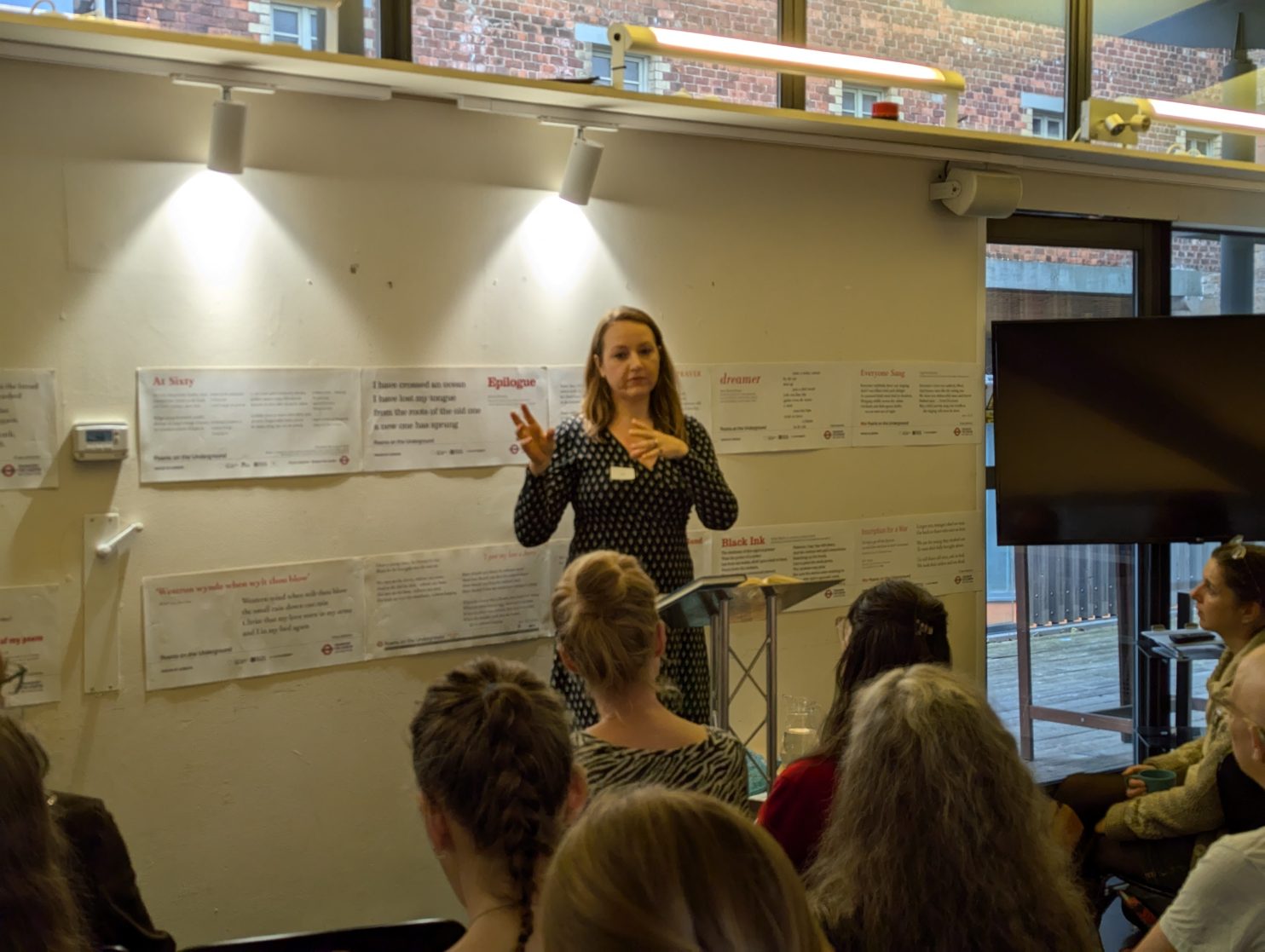May 24, 2025
Translation workshop: a how-to guide
SELTA’s former Chair Ruth Urbom shares her tried-and-tested formula for organising a successful translation workshop.
Translation workshops are a joy to participate in, as indicated not only by SELTA’s autumn event in 2024, but by its many predecessors over the years. The opportunity for members of an often-solitary profession to come together and both inspire and be inspired is priceless: but how best to go about planning a translation workshop yourself?
Former chair Ruth Urbom has put together a fantastic guide for those of you looking to do just that.
———
It’s gratifying to see that the format for practical translator workshops I developed back in 2011 has proven robust enough to continue with new organisers.
By my count, SELTA has now hosted a total of nine workshops using my format. I have been pleased to see favourable feedback from participants over the years, most recently following SELTA’s event at the Scottish Poetry Library in Edinburgh.
Unlike translation slams, where two or three people are placed in the spotlight with other attendees relegated to onlooker status, this workshop format allows everyone – beginners and old hands alike – to take part on an equal footing.
To enable even more fellow translators to benefit from this stimulating, rewarding activity, I am sharing the organisational framework for my workshop format in this how-to article.
Preparation
Around 4–6 weeks before the workshop date, the facilitator selects a stretch of text – which may be a standalone piece or part of a longer work – and distributes it to the participants. All workshop participants translate the same set text.
An extract that results in 600–750 words of English (between two and three printed book pages) will provide plenty of material for a whole afternoon’s discussion, without being too onerous for participants to prepare.
Some translators feel more confident if they can read the whole work before tackling the extract. For many of SELTA’s workshops, we have been fortunate to obtain a complete PDF of the book from the rights holder (usually the author’s literary agent), with permission to share the file with workshop participants. Participants are advised not to forward the book PDF to anyone outside the workshop group, so as not to deprive the author of sales.
Participants each email their own translation of the extract to the facilitator in Microsoft Word or .rtf format around 7–10 days before the workshop date. The facilitator then removes any translators’ names or other identifying details from the translations received and assigns a number to each one before emailing the whole set of translations out to all participants. That gives everyone time to look through the different translated versions and identify interesting aspects before the group meets to discuss them.
Some people might be unable to attend the workshop discussion session but still wish to be involved. In those cases, I encourage them to submit a translation anyway. In return, I send them the full bundle of translations so that they can analyse and compare the various versions on their own.
I always standardise the font, line spacing, paragraph indentation and margins in the submitted translations before distributing the bundle of numbered, now-anonymous pieces. Having a uniform layout across all the versions helps to focus everyone’s attention on what’s essential: the content of the translations.
It can also be helpful to add line numbers in the margin to make it quick and easy to refer to particular points during the discussion. That can be done with just a couple of clicks in Word.
Word counts for each translated version are another bit of useful information to include. It’s illuminating to see the extent to which the source text expands through translation. Some translators may use a more concise style, while others employ more explicitation, preferring to ‘unpack’ certain expressions or cultural phenomena for target-language readers.
I concatenate all of the translations received into a single document and save the file as a PDF to send out. That ensures everyone will be on the same page (literally!) in the discussion, whether they use A4 or North American letter-size paper.
If the author is going to be involved in the workshop, I also send everyone’s translations to the author or his/her representative ahead of time.
Participants are asked to bring the translation bundle to the workshop, either as hard copy or on their laptop or tablet, so that they can refer to the translations during the discussion. As facilitator, I take an extra printout to the discussion session to help anyone who’s forgotten to bring theirs along – there’s usually at least one.

On the day
One way to kick off the workshop is by discussing the source text. What sort of work is it? Who is the target audience? How would you describe the writer’s style, the narrator’s voice, the characters, the setting? Are there any passages you found particularly challenging – perhaps due to culturally bound terms, tricky linguistic structure or wordplay? That provides a natural opening for the discussion to turn towards the group’s translations.
It is rare for two translators to translate any sentence (other than very brief, unambiguous expressions) in exactly the same way. Further discussion of the text can elicit even more potential translation solutions beyond what the participants came up with individually.
I take care to maintain the anonymity of participants’ translations – and by the time of the actual workshop, I’ve forgotten who submitted which one anyway. I tell the group they can choose to reveal which one is theirs if they wish to explain the reasoning behind their decisions, e.g. “Version 3 is mine, and I chose that wording because I wanted to emphasise [xyz]…”
SELTA has often had the privilege of having one or more authors attend our workshops in person, thanks to funding from the Swedish Arts Council and the Anglo-Swedish Literary Foundation. It’s a real luxury to be able to address specific questions about the text directly to the author and so acquire a deeper understanding of the work. If the author is unable to be present with the group, an alternative is to email the bundle of translations to the author and invite him/her to comment on them.

Many benefits
This translation workshop format can help experienced translators freshen up their own practice with new solutions to frequently encountered phrases or grammatical structures. It’s reassuring to know that other translators struggle with the same thorny aspects of a text. Students and emerging translators can gain insights into more experienced colleagues’ thought processes, as well as when and where they might be able to depart from the source sentence structure to create a translation that works better in the target language – for example, by swapping around the order of clauses within a sentence, or by splitting or combining sentences or even paragraphs differently.
Keeping the translations anonymous allows people to look objectively at different versions of the text without being overawed by any senior colleagues’ names attached to particular translations in the bundle.
Workshops can serve as a ‘safe space’ for translators to try out bold tactics they might not feel justified employing on paid projects, just to see how they work. For example, I once used the simple past tense in my translation of a Swedish novel extract that was set in the 1980s and written in the historic present. That’s not something I’d ever do on a real job without prior approval from the author and editor, but I wanted to spark discussion on the relative markedness of present versus past in Swedish and English. (The author didn’t like the change at all!)
Authors get a lot out of these workshops too. They find it fascinating to see all the different potential English versions of their writing, and translators’ questions can lead to further reflection on their own writing practice – as the Swedish author Elin Olofsson shared in an essay following SELTA’s 2017 workshop on Nature [in] Writing.
SELTA’s workshops to date have covered novels, children’s fiction and picture books, poetry, non-fiction and even a graphic novel. There’s no reason this format couldn’t be used with a source text from the commercial realm, such as a press release, news article or annual report. Virtually any piece of writing will contain ambiguities and idiomatic expressions that require translators to interpret the source and make their own choices about how to render the text into their target language.
Translation workshops are a great opportunity for translators to geek out about fine nuances of meaning and style. Why not get a group together and try it for yourselves?
Ruth Urbom
SELTA Chair 2012–2018

